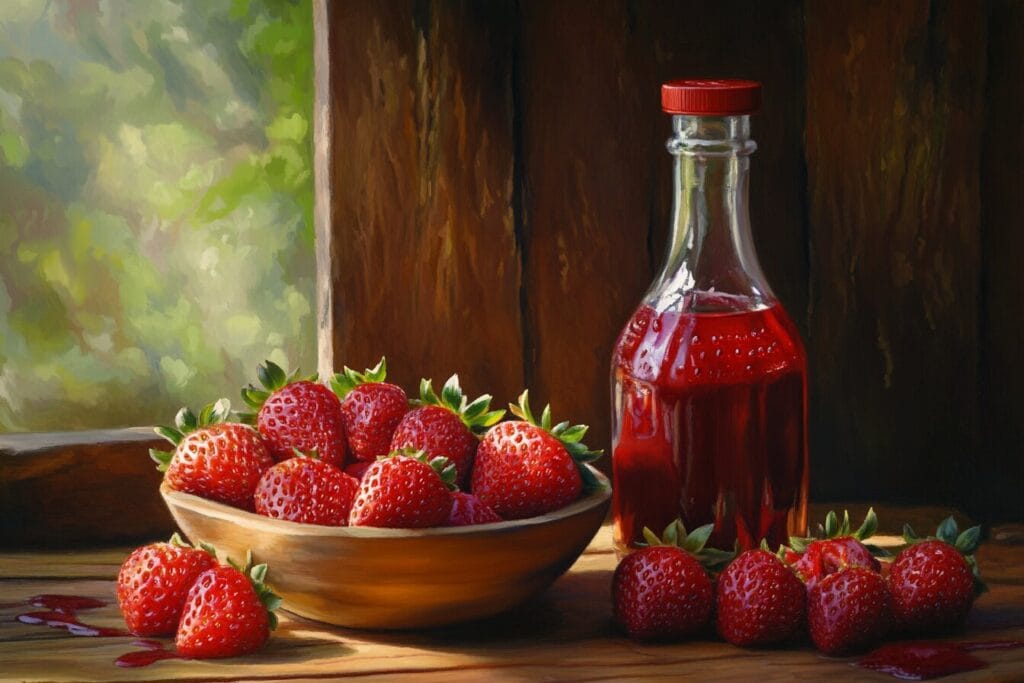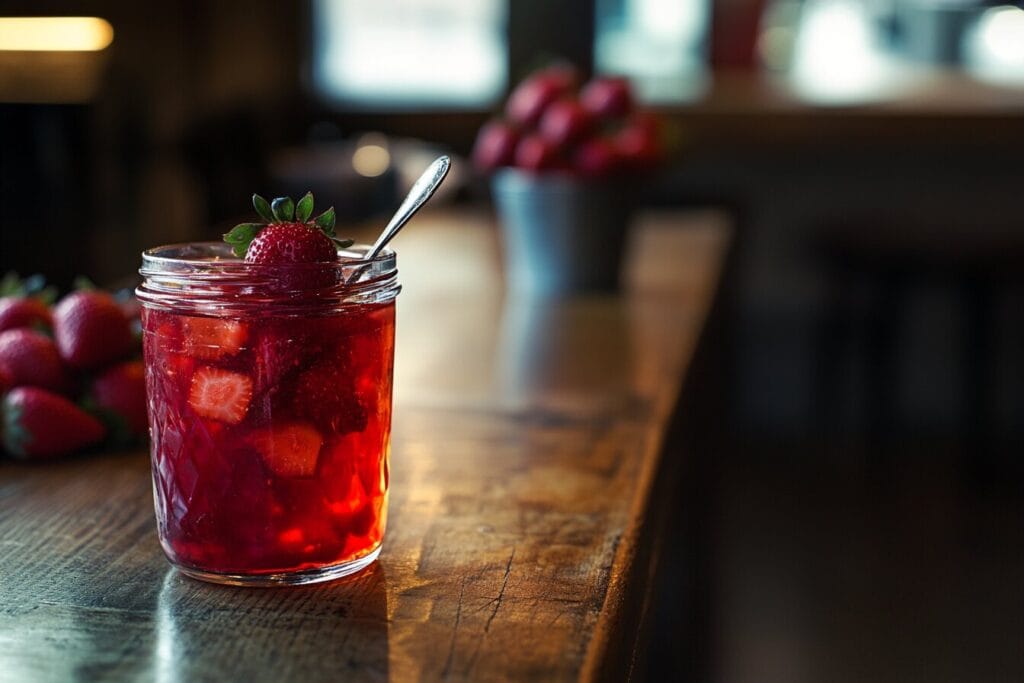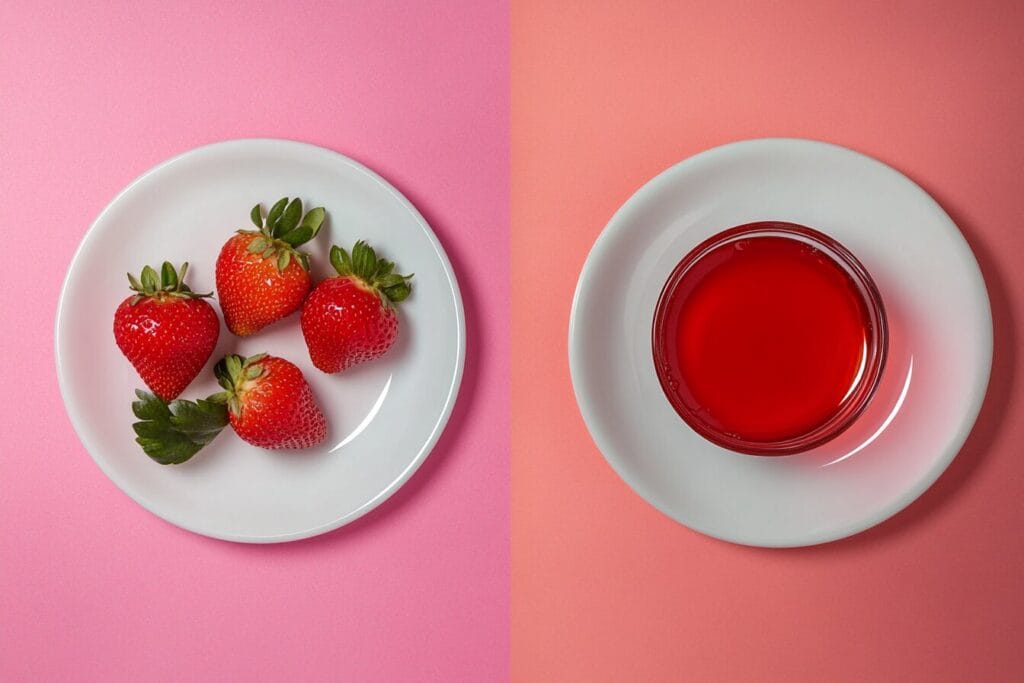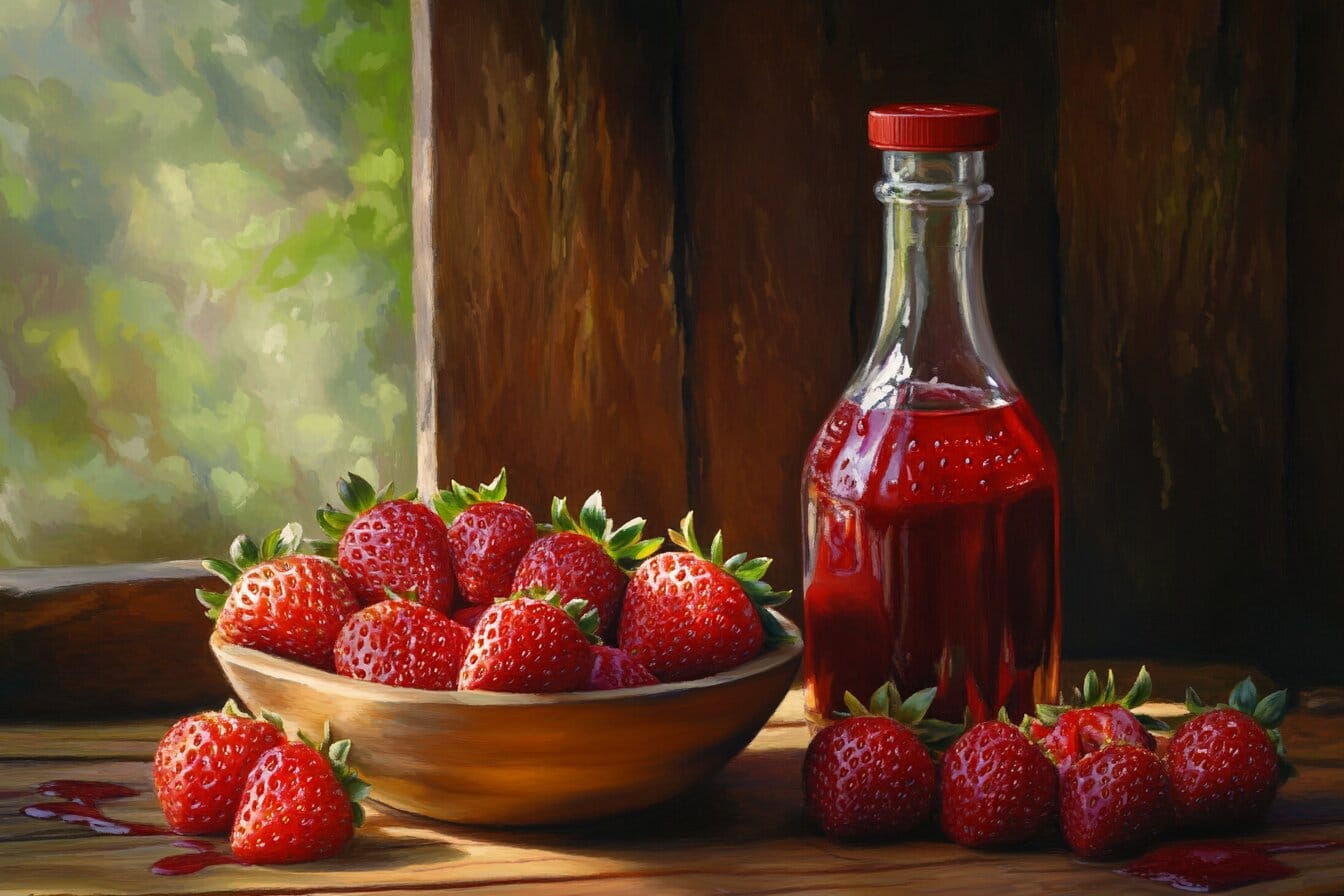People around the world love strawberries for their sweet and tangy flavor, which adds a delightful touch to desserts, beverages, and savory dishes. Among the various ways to process strawberries, strawberry puree and strawberry syrup emerge as versatile options. So, what sets these two strawberry-based products apart, and how do you decide which one to use?
In this article, we’ll dive into the differences between strawberry puree and strawberry syrup. We’ll examine their production processes, texture, flavor, nutritional values, and culinary applications. By the end, you’ll have a clear understanding of which option is best suited for your recipes or preferences.
Introduction
Why Compare Strawberry Puree and Syrup?
Strawberry puree and syrup may seem interchangeable at first glance, but they cater to distinct needs. While puree preserves the natural essence of strawberries, syrup is often designed for convenience and sweetness. Whether you’re crafting a smoothie, topping pancakes, or creating a gourmet dessert, knowing the differences will help you achieve the desired taste and texture.

Understanding Strawberry Puree
What is Strawberry Puree?
Strawberry puree is a thick, smooth blend of strawberries that captures the fruit’s natural flavor, aroma, and color. It’s essentially strawberries processed into a liquid form, often without adding sugar or preservatives, making it a favorite for recipes that require a fresh and natural strawberry taste. Unlike other strawberry products, puree retains the integrity of the fruit, offering a vibrant, true-to-nature experience.
How is Strawberry Puree Made?
Making strawberry puree involves a straightforward process:
- Selecting Fresh Strawberries: The quality of the puree largely depends on the ripeness and sweetness of the fruit.
- Washing and Hulling: Strawberries are washed and hulled to remove dirt and the leafy tops.
- Blending: The cleaned berries are blended into a smooth consistency. Depending on the recipe, seeds may or may not be strained out.
- Optional Additives: While traditional puree contains only strawberries, some versions include sugar, lemon juice, or other stabilizers to enhance flavor and shelf life.
The simplicity of the process makes strawberry puree a favorite for homemade recipes and professional kitchens alike.
Key Characteristics of Strawberry Puree
Strawberry puree is distinct from syrup in several ways:
- Texture: It has a thick, pulpy texture, making it ideal for recipes requiring a natural, unprocessed strawberry feel.
- Flavor: The taste is fresh, slightly tangy, and less sweet compared to syrup.
- Appearance: Puree has a rich, deep red color that varies depending on the strawberries used.
- Shelf Life: Homemade puree is perishable and typically lasts only a few days in the refrigerator without preservatives.
Exploring Strawberry Syrup
What is Strawberry Syrup?
Strawberry syrup is a sweet, liquid-based product made from strawberries, sugar, and sometimes other ingredients like corn syrup or artificial flavors. Unlike puree, it’s primarily used as a sweetener or topping. The syrup’s consistency is smooth and runny, designed for easy pouring or mixing into drinks and desserts.

How is Strawberry Syrup Made?
Commercial strawberry syrup production is more complex than puree, involving processes that enhance its sweetness, shelf stability, and ease of use. The basic steps include:
- Cooking Strawberries with Sugar: Fresh or frozen strawberries are boiled with sugar to extract flavor and create a sweet liquid.
- Straining: The mixture is strained to remove solids, leaving a smooth, liquid syrup.
- Adding Preservatives: Ingredients like citric acid or stabilizers may be added to increase shelf life.
- Optional Artificial Additives: Some brands include food coloring or artificial flavors to enhance appearance and taste.
Homemade strawberry syrup is also an option, but it generally contains fewer additives and has a shorter shelf life.
Key Characteristics of Strawberry Syrup
- Texture: Smooth and liquid, perfect for drizzling or mixing.
- Flavor: Intensely sweet, often with added sugars to appeal to a broader audience.
- Appearance: Bright red, often more uniform in color due to artificial coloring.
- Shelf Life: Store-bought versions can last for months, thanks to preservatives.
Key Differences Between Strawberry Puree and Syrup
Composition: Puree vs. Syrup
One of the primary distinctions lies in the ingredients and preparation methods.
- Strawberry Puree: Typically made with 100% strawberries, it may include a small amount of sugar or lemon juice for flavor enhancement. The focus is on preserving the fruit’s natural qualities, with minimal processing.
- Strawberry Syrup: Contains a mixture of strawberries (or sometimes strawberry flavoring), sugar, water, and stabilizers. Many commercial syrups also include artificial flavors or colors to enhance their appeal.
In short, puree emphasizes naturalness, while syrup is engineered for sweetness and convenience.
Texture and Consistency Differences
Texture plays a pivotal role in choosing between the two.
- Strawberry Puree: Thick and pulpy, with a natural texture that reflects the fruit’s original form. It may include seeds unless strained. This consistency makes it ideal for recipes where the texture of real strawberries is desired, such as in smoothies or sauces.
- Strawberry Syrup: Smooth and runny, with no pulp or seeds. Its liquid consistency is designed for easy mixing into drinks or drizzling over desserts.
The texture difference can also impact the visual appeal of a dish or beverage, depending on the desired presentation.
Flavor Profile Comparison
The flavor profiles of strawberry puree and syrup vary significantly due to their preparation methods.
- Strawberry Puree: Offers a fresh, tangy taste that closely mirrors the flavor of fresh strawberries. The natural sugars in the fruit shine, making it less sweet and more balanced.
- Strawberry Syrup: Intensely sweet, often dominated by added sugars. While strawberry syrup provides a strong strawberry-like flavor, it may lack the complexity and freshness of real fruit.
For those seeking an authentic strawberry experience, puree is the superior choice, while syrup caters to those who prefer heightened sweetness.
Uses and Applications of Each
Both strawberry puree and syrup are versatile, but their distinct characteristics make them suitable for different culinary applications:
- Strawberry Puree:
- Used in smoothies, sorbets, and desserts that require a natural strawberry base.
- Popular in baking for creating fillings or layers in cakes and pastries.
- Ideal for sauces or coulis in gourmet dishes.
- Strawberry Syrup:
- Commonly drizzled over pancakes, waffles, and ice cream.
- A favorite for sweetening beverages like cocktails, lemonades, and sodas.
- Used in commercial baking for a consistent and sweet strawberry flavor.
The choice often comes down to the recipe’s requirements and whether the focus is on sweetness or authentic strawberry flavor.
Health and Nutritional Aspects
Nutritional Content of Strawberry Puree
Strawberry puree is known for its nutritional benefits, largely due to its minimal processing and natural ingredients. Here’s what makes it a healthier choice:
- Calories: Puree is relatively low in calories, as it consists primarily of strawberries without added sugar.
- Vitamins and Minerals: Rich in vitamin C, folate, potassium, and manganese, strawberries in puree form retain their natural nutrient profile.
- Dietary Fiber: The pulp in strawberry puree contributes dietary fiber, aiding digestion and promoting gut health.
- Natural Antioxidants: Strawberries provide a powerhouse of antioxidants like anthocyanins and ellagic acid. These compounds remain intact in puree and actively combat oxidative stress.
Homemade or minimally processed strawberry puree is an excellent option for health-conscious individuals who prioritize nutrient density and natural ingredients.

Nutritional Content of Strawberry Syrup
Strawberry syrup, particularly commercial varieties, differs significantly from puree in its nutritional composition:
- Calories: Syrup is higher in calories due to added sugars and sweeteners, often containing 50–70 calories per tablespoon.
- Sugar Content: The most prominent feature of strawberry syrup is its sugar content. Many brands include high-fructose corn syrup or refined sugar to enhance sweetness.
- Low Nutritional Value: Unlike puree, syrup loses much of the fruit’s natural vitamins, minerals, and antioxidants during processing.
- Additives: Manufacturers often use preservatives, artificial flavors, and food coloring to enhance shelf stability and visual appeal. However, these additives may not suit individuals following health-focused diets.
Added Sugars and Preservatives: A Health Perspective
The inclusion of added sugars and preservatives in strawberry syrup poses some health concerns:
- Impact on Blood Sugar Levels: The high sugar content in syrups can lead to spikes in blood glucose levels, making it unsuitable for individuals with diabetes or those following low-sugar diets.
- Artificial Additives: Some syrups use synthetic ingredients that may not be ideal for natural or organic diets.
- Calories Without Nutrients: Syrups often provide empty calories, lacking the fiber and micronutrients found in strawberry puree.
In contrast, strawberry puree’s natural composition makes it a more balanced and wholesome option. However, it’s important to note that puree may also include added sugar when purchased commercially, so reading labels is essential.
Choosing the Healthier Option
For those prioritizing health, strawberry puree is generally the better choice due to its minimal processing and natural benefits. Opting for homemade puree further ensures control over added ingredients. Meanwhile, syrup can still be enjoyed in moderation for its sweetness and convenience.
Culinary Uses and Recipes
Using Strawberry Puree in Recipes
Cooks and food enthusiasts prize strawberry puree for its versatility in recipes that need a natural, fruity base. Its fresh flavor and thick consistency make it a popular choice in the culinary world. Here are some popular applications:
- Smoothies and Beverages:
Strawberry puree blends seamlessly into smoothies, milkshakes, and mocktails. Its natural sweetness reduces the need for additional sugar, creating a healthier drink. - Baking:
Puree can be used as a filling for cakes, pastries, and pies. It’s also ideal for adding moisture and flavor to muffins and quick breads. For a burst of freshness, swirl it into cheesecake or layer it in trifles. - Desserts:
- Strawberry coulis, made from puree, is a common topping for panna cotta, ice cream, or custards.
- Blend it into sorbets or use it as a base for fruit popsicles.
- Savory Dishes:
Puree can be incorporated into sauces for meats like duck or pork, adding a sweet-tart contrast to rich flavors.
Recipe Idea: Strawberry Puree Smoothie Bowl
- Ingredients:
- 1 cup strawberry puree
- 1 banana
- 1/2 cup Greek yogurt
- Toppings: granola, sliced fruits, and chia seeds
- Instructions:
Blend the puree, banana, and yogurt until smooth. Pour into a bowl, add toppings, and serve.
Recipes Highlighting Strawberry Syrup
Strawberry syrup is celebrated for its sweetness and ability to enhance both beverages and desserts. Its liquid form makes it a convenient ingredient in the following:
- Drinks:
- Stir strawberry syrup into lemonade for a fruity twist.
- Add it to cocktails like margaritas, daiquiris, or mojitos for vibrant flavor and color.
- Mix with milk for a classic strawberry milk treat.
- Desserts:
- Drizzle syrup over pancakes, waffles, or French toast.
- Use it as a topping for ice cream sundaes, yogurt parfaits, or crepes.
- Incorporate it into frosting or glazes for cakes and cookies.
- Quick Recipes:
- Add syrup to whipped cream for a strawberry-flavored topping.
- Use it to sweeten oatmeal or porridge.
Recipe Idea: Strawberry Syrup Lemonade
- Ingredients:
- 2 tablespoons strawberry syrup
- 1 cup lemonade
- Ice cubes and mint leaves for garnish
- Instructions:
Mix the syrup into the lemonade, stir well, and serve over ice. Garnish with mint leaves for a refreshing finish.
How to Substitute Puree for Syrup and Vice Versa
There are instances where you might want to substitute one for the other, depending on availability or desired flavor profile.
- Using Puree in Place of Syrup:
- Add a sweetener like honey or sugar to mimic the sweetness of syrup.
- Strain the puree for a smoother, more syrup-like consistency.
- Using Syrup in Place of Puree:
- Dilute syrup with water or blend with fresh strawberries to replicate the texture of puree.
- Be mindful of sweetness, as syrup is significantly sweeter than puree.
Understanding how to adapt recipes with these substitutions can expand your options and enhance your creativity in the kitchen.
Frequently Asked Questions (FAQs)
Can I Make Strawberry Puree from Syrup or Vice Versa?
Yes, it is possible to make strawberry puree from syrup or convert puree into syrup, though the results may not be identical to the originals.
- To Make Puree from Syrup: Combine strawberry syrup with fresh or frozen strawberries and blend until smooth. This will add back some of the fruit’s natural texture and flavor.
- To Make Syrup from Puree: Simmer strawberry puree with sugar and a little water until it reduces to a syrupy consistency. Strain to remove any pulp or seeds.
Which is Better for Cocktails, Puree or Syrup?
Both puree and syrup work well in cocktails, but the choice depends on the desired flavor and presentation:
- Puree: Adds a fresh, fruity texture and vibrant taste to cocktails like daiquiris or margaritas. It’s best for thick or blended drinks.
- Syrup: Easier to mix in and offers a smoother consistency, making it ideal for clear or stirred cocktails like mojitos.
Are There Sugar-Free or Low-Calorie Versions of Puree or Syrup?
Yes, there are options for both:
- Sugar-Free Puree: Homemade strawberry puree made from fresh or frozen strawberries, with no added sugar, is naturally low-calorie.
- Sugar-Free Syrup: Commercially available sugar-free syrups use artificial sweeteners like stevia or erythritol, offering a low-calorie alternative.
When choosing store-bought products, check labels for added sugars and artificial ingredients.
Can I Use Both in the Same Recipe?
Absolutely! Strawberry puree and syrup can complement each other in recipes. For instance:
- Use puree as a base and drizzle syrup on top for layered desserts.
- Blend both into a smoothie for a balanced sweetness and natural texture.
- Pair puree in a cake filling with syrup in the glaze for a cohesive strawberry flavor.
Combining the two can enhance flavor and presentation, depending on the dish.
How Long Does Strawberry Puree or Syrup Last?
The shelf life of each product depends on its preparation and storage:
- Strawberry Puree:
- Homemade puree lasts 2–4 days in the refrigerator.
- Commercially processed puree with preservatives can last up to 2 weeks once opened.
- Strawberry Syrup:
- Homemade syrup lasts 1–2 weeks in the refrigerator.
- Store-bought syrup with preservatives can last for months if sealed and stored properly.
To extend freshness, freeze puree in portions or use sterilized containers for homemade syrup.
Conclusion
Strawberry puree and strawberry syrup each have unique qualities that cater to different culinary needs. While puree offers a natural, less sweet option with fresh fruit flavors, syrup provides convenience and intense sweetness, perfect for topping and sweetening. Whether you’re preparing a gourmet dish, a simple breakfast, or a refreshing drink, understanding their differences ensures you choose the right ingredient for the job.
By exploring their composition, uses, and health aspects, you can make informed decisions and enjoy the best of both worlds.

